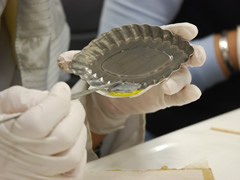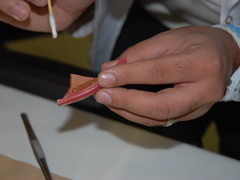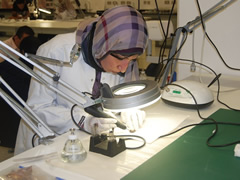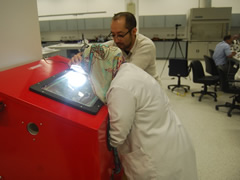- Home
- Technical Cooperation Projects
- Index of Countries
- Middle East
- Egypt
- The Project for the Conservation Center in the Grand Egyptian Museum
- Project News
- Inorganic Objects (Metals) Training course III was held
Project News
2015-09-08
Inorganic Objects (Metals) Training course III was held
At the Grand Egyptian Museum Conservation Center (GEM-CC), Japan International Cooperation Agency (JICA) conducted the training course on Metals (conservation treatment) from 2nd – 8th September, Instructed by 3 Japanese experts in this field as listed below:
- Dr. Akira Fujisawa: Lecturer, Institute of Cultural Properties, Teikyo University.
- Dr. Naomi Hemuki: Conservator
- Mr. Takashi Oikawa: Conservator
10 from the Conservation Center different labs members have participated in the course as main trainees, with an additional 5 members as observers.
The purpose of the conservation and restoration program is not simple transfer of restoration techniques. It is to build human resources and physical systems for overall conservation and restoration activities, which include documentation and condition survey, conservation and restoration policy decision, cooperation with conservation science, and production of survey and conservation report.
Although metallic cultural properties consist of various metals/alloys, this training features the conservation of metallic artifacts mainly made of bronze, and enable trainees to create a conservation plan based on the conservation ethics and scientific results.
The previous training (B-m-1(metal)) that was held in August, 2015, featured the condition survey of metallic artifacts, and trainees became able to evaluate the condition of metallic artifacts by observation and natural scientific survey and to collect necessary information for conservation treatment. So the aims and objectives of this training was:
- Introduce various conservation methods regarding artifacts mainly made of bronze including mechanical and chemical cleaning principle, stabilization treatment, consolidation treatment, joining and filling.
- Deepen the knowledge by practicing some of methods
- Become able to create an appropriate conservation plan based on the conservation ethics.
This training course focused more on practical practice, regarding the cleaning it was asserted that chemical treatment is used in some cases, and as for joining, we established trainees understanding about the importance of reversibility and retreatability in Joining. Ultimately trainees were able to answer the instructors' questions about planning the appropriate conservation plan.
 A trainee practicing filling
A trainee practicing filling
 A trainee practicing joining.
A trainee practicing joining.
 Trainee practicing mechanical cleaning.
Trainee practicing mechanical cleaning.
 Trainee practicing mechanical cleaning with sand blaster.
Trainee practicing mechanical cleaning with sand blaster.
- About JICA
- News & Features
- Countries & Regions
- Our Work
- Thematic Issues
- Types of Assistance
- Partnerships with Other Development Partners
- Climate Change / Environmental and Social Considerations
- Evaluations
- Compliance and Anti-corruption
- Science and Technology Cooperation on Global Issues
- Research
- JICA Development Studies Program / JICA Chair
- Support for the Acceptance of Foreign HRs / Multicultural and Inclusive Community
- Publications
- Investor Relations
